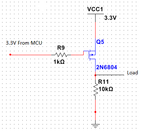alexan_e
Administrator
The resistor has a high value and is actually a weak pull up/down resistor , it can't force a value when the mcu drives the gate high or low, it is only there to apply a known state when the mcu output is not enabled or nor connected etc.
Alex
Alex



